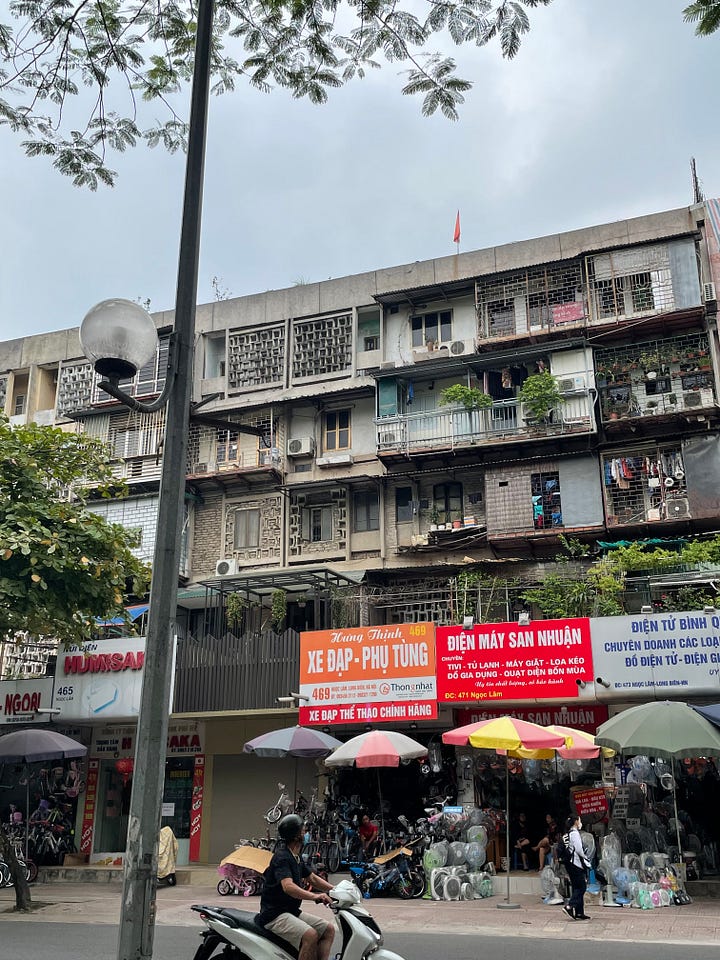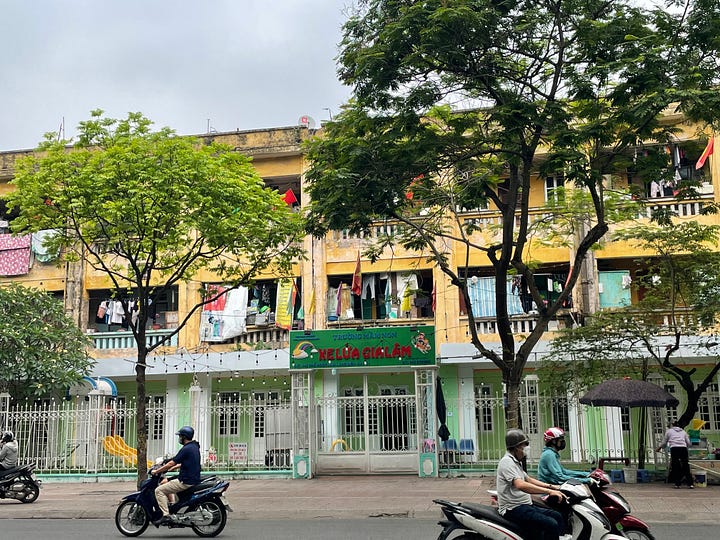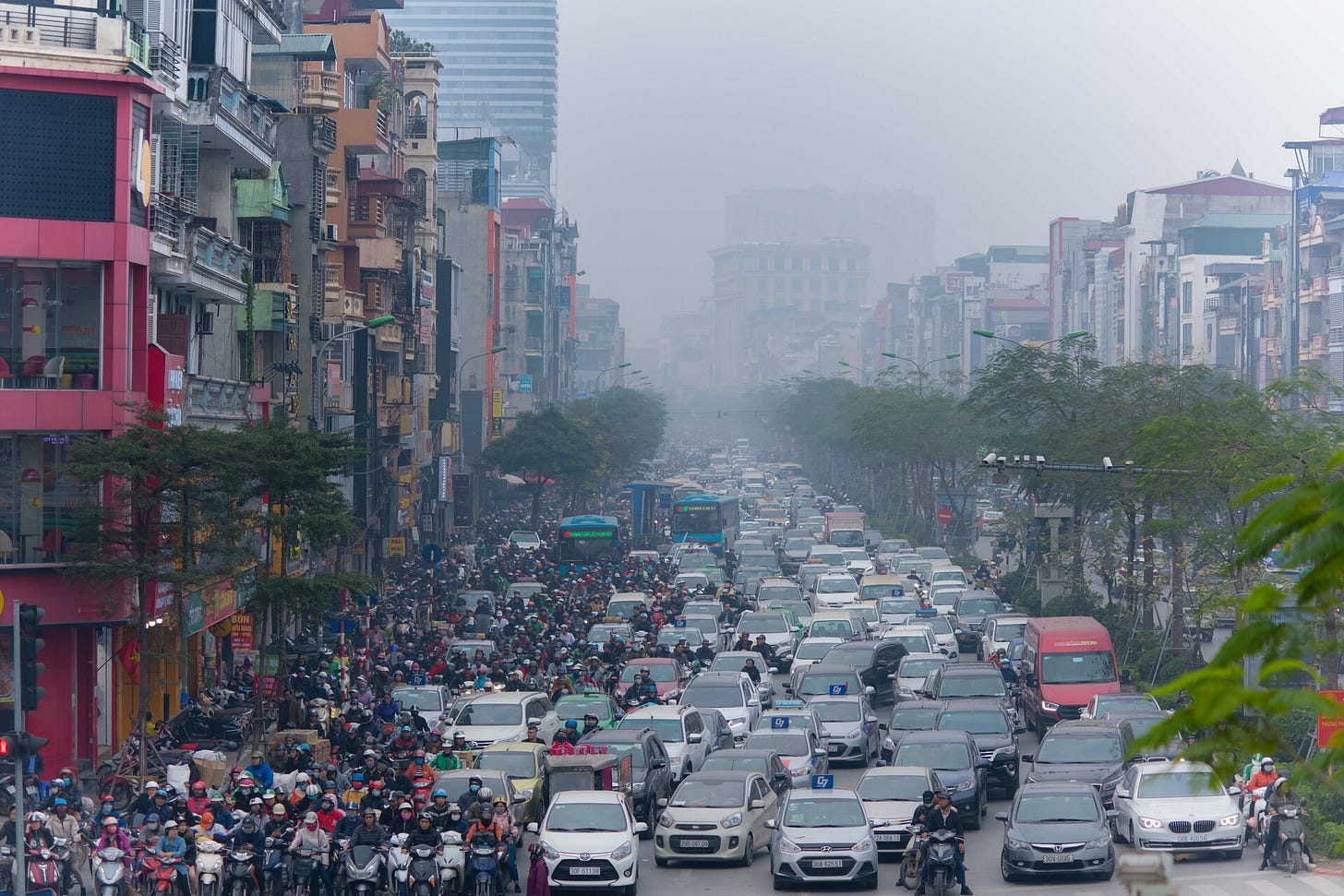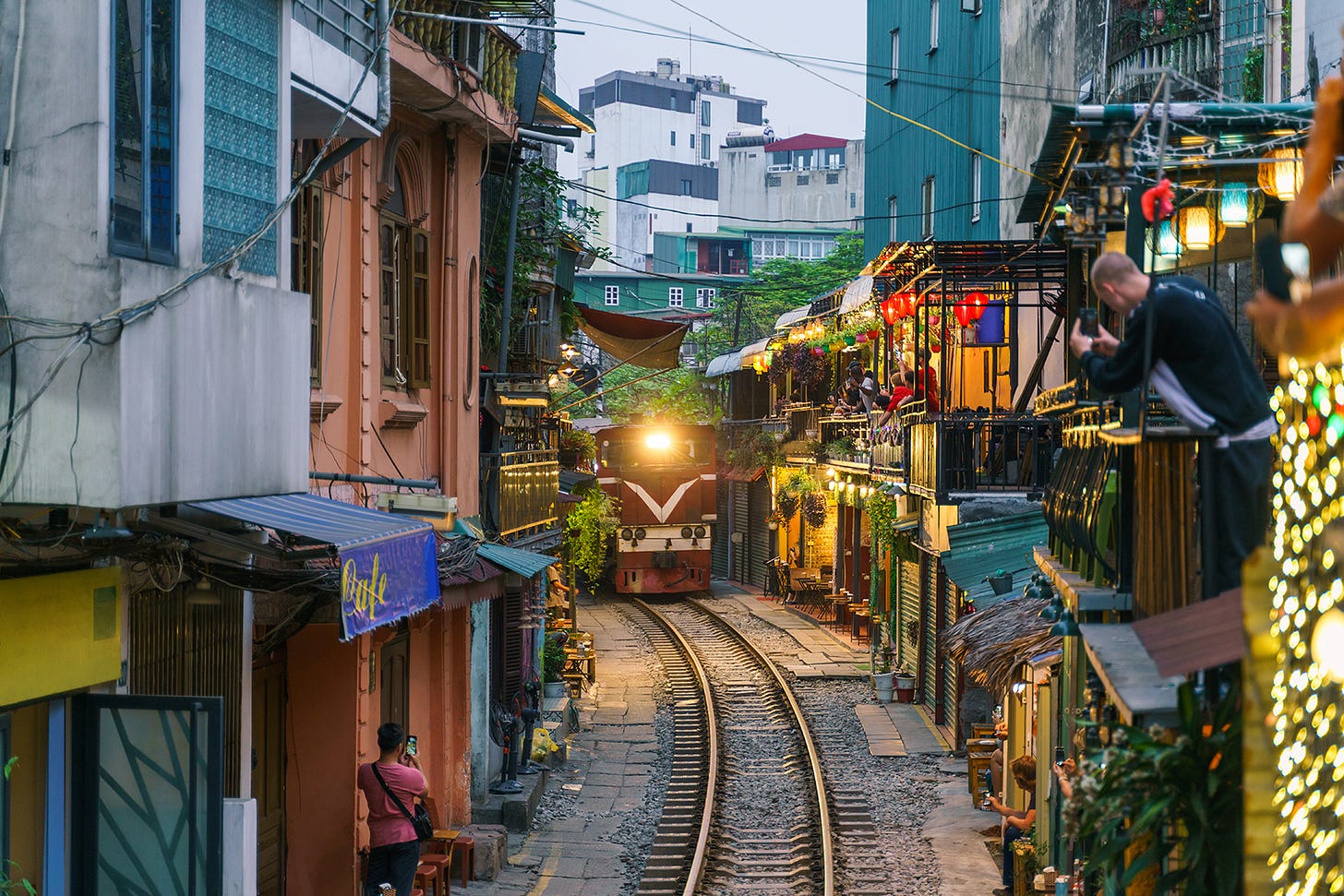The anatomy of a city: Hanoi (Part 1)
In this first part of a 3-part series, I recount my history with the city and take a good look at their appearance and taste
In my previous post, I have set out to detail the cities of my life, ones that I know. This is more of a personal endeavor more than anything, but I hope to inspire people to think differently, more profoundly, about these organic superstructures we inhabit, to consider them on their own merits as an independent individual.
In painting the city’s portrait, I try to not focus too much on details. I also make no pretense to illustrate all my sentiments with pictures. After all, masters before me have described the city in far greater detail than I ever can, and I’m not the most gifted photographer. The ultimate aim of this project, rather, is to paint an impression of the city, an impression that the reader already familiar with the place can take note of and project upon their own impression, and at the same time intriguing enough to entice would-be travellers to get to know Hanoi without the dogmatic dictation of TripAdvisor.
Because the city does not have a readily anthropomorphic form, to portray it is also to grapple in the dark. Unlike in a human where certain characteristics are immediately obvious: their height, their build, their gender, in cities there are no such things. This provides us with a rare opportunity to discover a soul while being impartial to its appearance: untethered by inescapable stereotypes on gender, appearance, and age one sees in humans, one talks with the human-city as if on a blind date. For this reason, I shall speak of cities in the singular ‘they’, unless sufficiently convinced to assign it to a binary gender.
My portraits will be incomplete. My portraits can be wrong (after all, cities sometimes do lead super-agent lifestyles beneath their innocuous façades). My portrait will be different from yours. And my portrait might not withstand the test of time: maybe one day, the city will change beyond recognition, or more likely, I will change beyond recognition, and so this relationship will also change beyond recognition. However, for now, this is my best attempt at delineating a human-city, and at this point in time, my most truthful contribution to the archives of worldly human-cities. I shall start with the city that inspired this project, Hanoi.
I. My personal history
I first met Hanoi when I was fourteen. At that age, I knew nothing about cities. Hanoi to me was just a grand extension of Haiphong; therefore, I have emblazoned my Haiphong sensibilities on it, basically rendering my first impressions as meaningless. I left Hanoi that time after a disappointing math competition, one that changed my trajectory in life, so in the next few years, I would speak of Hanoi with indifference and a mild bitterness.
From then on, my visits to Hanoi have been sporadic: I have never stayed in the city for more than a full week at a time. Therefore, I am in a unique place to appreciate Hanoi: never having lived there but having been there just enough to not be a total stranger. I have seen Hanoi in indirect visions, in addresses and photos, from my friends’ correspondence, have dreamt of it enough to construct a meaningful underpainting upon which the pigments of the actual city can settle. Returns upon returns, Hanoi is revealing themself to me, bit by bit. Meeting Hanoi is like meeting someone I’ve always admired but by circumstances have to part with, and so the rare occasions the two can meet become a source of invaluable glee. This person, whose genius was unseen to me when I was young, hasn’t changed much: it is purely because my mind has grown through university years that I started to appreciate their personality and eccentricities.
II. Hanoi’s appearance and tastes
Hanoi is full of juxtaposition. Here the old, the new, and the old-new co-exist. One would see an old French house refurbished into the classiest minimalist cafe on the inside. One will see old-school stores with their crude oversize letterings on plain backgrounds next to a bar, most deliberately designed to exude a certain, very specific vibe. One sees shoddy roadside diners that only locals visit next to tourist-haven souvenir shops that sells things about Hanoi which locals wouldn’t even think of in their busy everyday life. Architecturally, Hanoi is stuck in a whirlwind - being the greedy collector that they are, they try to gather everything in a haphazard, uncatalogued, senseless arrangement of architecture. Admittedly, it is quite hard to see a part of Hanoi where the architecture is uniform, so there is no satisfying transition in its style. Hanoi is proudly maximalist.
This juxtaposition feels even more drastic in my recent two trips, when I was staying in AirBNBs in the old quarter. From the window of a cozy, well furnished, hopelessly modern room, you see life in Hanoi going on like it has always been, not so touched by this dazzling modernity. I developed an enviable, almost ironic, appreciation of rustic life from the privilege of a most un-rustic room, in the meantime catching the passage of time on Hanoi's face. The old and the new are inextricably linked - trying to isolate either of them would result in an enormous yield loss. Time affects Hanoi's appearance, but not in a linear fashion1: while attempting to generally preserve their features, it made sneaky modifications here and there, creating the delightful mash of temporal marks we see today.
In a person, there are usually certain features truest to their essence, to which they can be reduced without losing too much of their complexity. Such essence of Hanoi, for me, are the socialist housing complexes (‘khu tập thể’ in Vietnamese). A socialist housing complex is a collage in itself. Units are arranged together, bearing some broad strokes of resemblance, but brimming with individual choices. Such a building reminds me of a group who has been given a dress code that can be interpreted too liberally. Some units protrude while others recede, some overflow with plants while other choose a spare façade, some are leaving their windows open for the outsider to take a peek in, while some, more reserved, has shut their blinds. This heterogeneity would be deemed heretic in other cities, but in Hanoi, it simply is how things are. In other cities, individuality is shut indoors; here, it is let grown organically, contributing to its endlessly colorful and disorganized appearance.


However, in its anarchy of aesthetics, there are still certain elements to be pinned down; this ensures that Hanoi’s style is pleasantly surprising and not painfully unpredictable. First, Hanoi is undoubtedly traditionally Vietnamese. The Temple of Literature, for example, stands defiantly in the city center as a beacon of Confucianism, having survived harrowing wars and destruction. There is a certain pride that Hanoi exhibits in retaining their original features from so long ago, a prestige of an aristocratic bloodline, a certain haughtiness over younger cities which they deem unsophisticated. Then Hanoi is also French. In fact, a majority of their iconic buildings in what we call the “old quarter” are French influenced, with the Opera House and Saint Joseph’s Cathedral being the most recognizable; this is probably why the overwhelming first impression of a tourist in Hanoi is a French one. Hanoi is quite natural in their French-ness, that is to say, their French aesthetics seem like something they’ve been nurtured in, not something they adopted recently in order to seem fashionable. This is perhaps because France has reigned over Vietnam for much of its transition to modernity, its influence seeping in an impressionable Hanoi, deleting their past or altering it beyond recognition. Finally, Hanoi is Soviet. Emerging from a painful war, Hanoi rebuilt itself in the Soviet spirit with ardour and urgency. This probably explains why the inclusion of Soviet influences sometimes feel jagged and unnatural, so brutalist they are against the backdrop of the more aesthetically driven French and Vietnamese influences, more similar to a sudden radicalization of ideas than the natural development of the latter.
It is not easy to pin Hanoi down however, for much as I feel some photos are unmistakably Hanoi, I cannot generalize them into a rule to teach the uninitiated how to tell Hanoi from other cities. While it clearly has an aesthetic, the exact definition eludes me - I would have to be content with a mixture of Vietnamese, French, and Soviet influences.
To me, Hanoi doesn’t wear any makeup. Nor are they well-groomed. If we see makeup as an effort to improve on one’s natural appearance, they are bare-faced to the point of neglect. Across the city we see pitiable efforts to plaster up a vandalized wall, grey-stained buildings from rain, and construction sites opening within busy roads like an untreated acne. The signboards along the roads, often faded beyond comprehensibility, is the dead giveaway of the city’s disregard for makeup. Hanoi’s residents seem to have surrendered to the city’s air, notoriously polluted, which will inevitably peel away colors and structures.
The tastes of Hanoi are peculiar, as we shall see: in this respect, I think of Hanoi as someone who, disillusioned by the pursuit of beauty, learned to appreciate imperfections, and once converted, became an ardent ambassador of imperfections. They are similar to an avant-garde painter who is splashing paint on the same canvases he used to paint the most realistic landscapes on.
Hanoi certainly is not lacking in flourish. The façade of Hanoi is impossibly detailed. No clean sweeps of organized lushness (often the result of careful urban planning) are to be found. No satisfying contour of the city’s skyline is to be seen, like in Singapore (which I will talk about later). There is always some details sticking out like a sore thumb: a balcony in the middle of nowhere, a geometrically irrational building, an antenna sprouting from a well-trimmed horizon of roofs. One might thought that these are a result of a lack of attention to detail; however, knowing Hanoi, it is quite the contrary: I feel like Hanoi, paying too much attention to detail, has implanted these irregularities like Easter eggs, deliberately disrupting any monotony in form, provoking curiosities in the bewildered visitor. Admittedly, they might have went overboard, and now they serve more as a source of annoyance than intrigue.
Nor is the city lacking in sophistication. Having been the cultural capital of a nation for more than a thousand years has its merit. Having been steeped in a tumultuous history, the city is home to an impressive artistic record, absorbing influences from traditional Vietnamese, as well as French and Soviet art. In modern days, they use this life force to sustain a cultural elite both referential and full of originality (more on this later, when we discuss Hanoi’s manner and lifestyle).
However, I would be hesitant to call Hanoi “fashionable”, or at least in the traditional sense; Hanoi is too ambitious and lacking in edit to be so. I imagine they would wear a multicolored patchwork jacket over hot pink trousers. Hanoi probably reads fashion magazines but doesn’t aspire to be on fashion magazines. I feel that Hanoi is very aware of aesthetic theories - there are places within Hanoi so lovely they cannot come from a tasteless person, however accidental - but they, either out of an impulsive nature or deliberate irreverence, fail to conform. At the same time, I think Hanoi is unashamed of their haphazardness, instead taking great pride in it. Meeting Hanoi at dinner, their collar ruffled and their shirt messily tucked, I would be puzzled whether such messiness were due to the lack of grooming time, or due to too much grooming time (in which the city had added some messiness to its outfit for fear of looking too proper, too edited).
Hanoi is true camp2. The recently closed train street is one great testament to Hanoi’s campiness. It is a train track cutting straight through crowded homes, refurbished to become a top tourist destination. It’s camp because in its failure to serve it’s original purpose, it becomes a theatricalized version of itself, and become appreciated for it; the absurdity of the place - as evidenced by foreign tourists’ disbelief at the sight of it - contributes majorly to the appeal. The best part: the train was still functioning through the street! As safety concerns led to the place’s closure, I lament the death (?) of a camp icon (who, perhaps unsurprisingly, is still clinging on to their last chance at life)
The fact that Hanoi pays little attention to being presentable might suggest that Hanoi is down-to-earth. However, I truly believe that Hanoi really is quite vain. In fact, they are too vain to admit that there’s a possibility that they’re in bad taste: in Hanoi’s head, the camp taste, the appreciation of ugliness and failure, is the superior taste, and they hold their head high in pride, paying absolutely no regard. This behavior is utterly objectionable to purists who insist that there is such a thing as good taste, and a considerable source of embarrassment for passer-bys; to their close friends however, it is just a peculiarity both amusing and incorrigible, and therefore no use bothering. Sometimes, as someone comment about how hideous my friend's new jacket is, I reply "that's just how he is", partly agreeing with the commenter, partly admiring the victim for displaying such unfaltering commitment to their taste as I suspect that deep down, they can feel their jacket's ugliness - that's how I feel when people complain that Hanoi is "too much".
(to be continued)
in the next part, we shall see that this is not the only temporal anomaly that Hanoi exhibits, when we examine their habit and manners.
the camp taste, in essence, is an appreciation of things that are “so bad it’s good”, putting more focus on style than on content. Susan Sontag wrote extensively on this in her (in)famous Notes on Camp.





